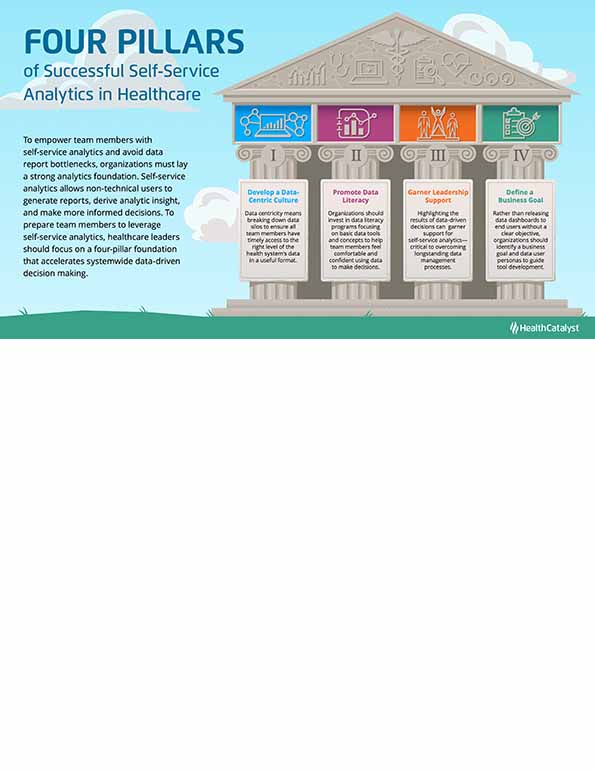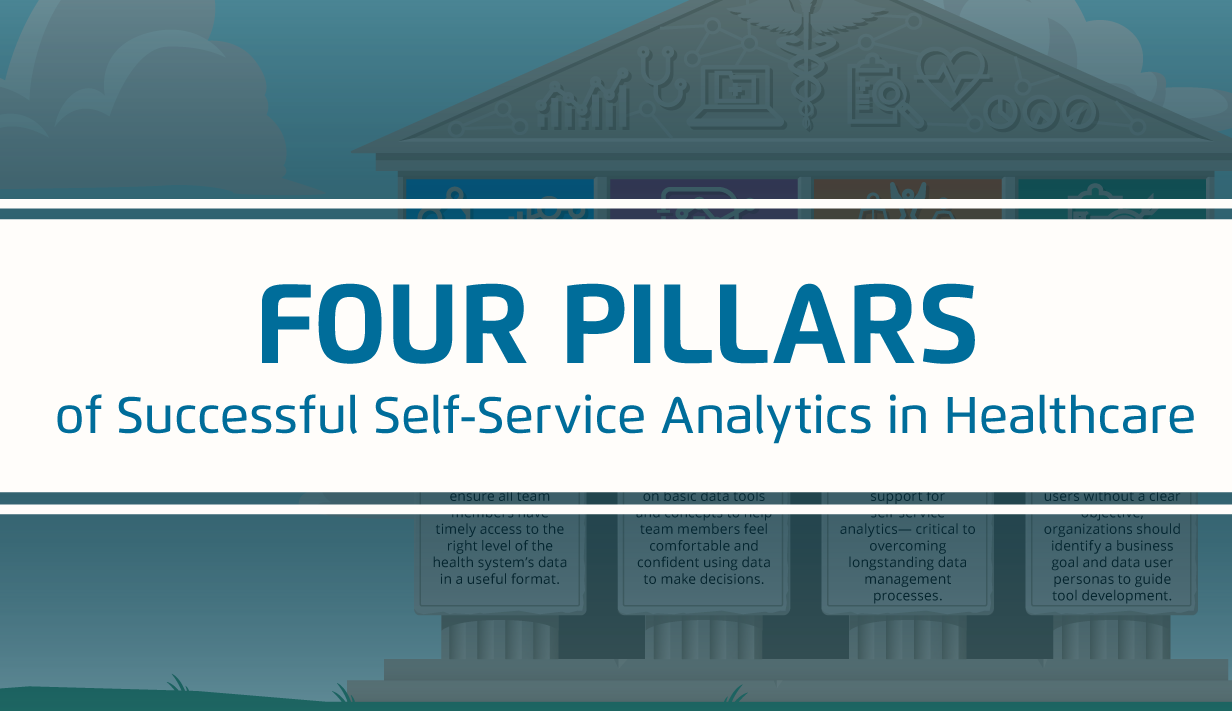Self-service analytics can empower healthcare organizations to better leverage business intelligence, enabling non-expert users to explore data sets, create custom reports and dashboards, and share valuable insights. However, without the right foundation, self-service analytics won’t reach its potential. Four pillars for success include the following:
1. A data-centric culture.
2. Data literacy.
3. Leadership support.
4. A defined business goal.



Self-service analytics can empower healthcare business intelligence (BI) across organizations, enabling decision makers to leverage data and analytics on their own, avoiding the common bottleneck of waiting for a data analyst or IT team to deliver a report or respond to a request. Powered by accessible, no-code tools with basic analytics capabilities, a self-service analytics platform enables non-data experts within an organization to explore data sets, create custom reports and dashboards, and share valuable insights.
Immediate access to relevant data with self-service analytics can drive more informed decision making at every level of the organization, resulting in better financial and clinical outcomes. However, many leaders encounter problems with self-service analytics when they rush implementation and don’t lay the critical groundwork necessary for success—a data-centric culture, data literacy, leadership support, and clearly defined business goals. To ensure self-service analytics success and accelerate systemwide data use, organizations must thoroughly prepare before implementation and maintain agility during and after.
For team members to avoid common problems with BI and help data reach its full potential, health systems should focus on the four pillars of a strong self-service analytics foundation:
Team members can’t value data if they can’t access it, making a data-centric culture critical for successful self-service analytics. Data centricity starts with data democratization—breaking down data silos to ensure all team members have timely access to the right level of the health system’s data in a useful format.
To guide effective data democratization, organizations should first understand that data is constantly changing. The best way to support this constant change is to invest in a robust data self-service data platform, such as the Health Catalyst Data Operating System (DOS™). An advanced data platform is critical for a data-centric culture because it can quickly combine data from multiple sources and distribute pertinent data to end users rather than forcing them to seek out different data sets and manually combine them. When team members can more easily access data through a data platform, they are more likely to use it, creating a culture that values and trusts data to drive decision making.
To successfully promote self-service analytics, organizations can invest in data literacy programs to train team members who are not data experts how to read, work with, analyze, and communicate with data. Data literacy training focusing on basic data tools and concepts helps team members feel comfortable and confident using data to make decisions.
Often, some team members will organically become “data champions” due to literacy programs and self-service analytics. Data champions are individuals who are passionate about using data effectively and can help other team members within their discipline (e.g., the cardiology department or decision support) feel more comfortable using data. Data champions can be an invaluable part of maintaining a data-driven culture and closing gaps in the analytical strategy. After data teams identify data champions, they should recognize and encourage these team members, further promoting the value of data and data champions.
Without data literacy support, team members might refrain from using data in their day-to-day jobs because they lack the know-how. For example, specific data sets about different patient populations could reveal the risk of readmission for different cohorts within a population. If the population health leader doesn’t feel comfortable using the data, she will most likely use less accurate information to inform her decisions, leading to suboptimal results. Inversely, if she had received data literacy training or had a data champion on her population health team, she would likely reference the data or ask that team member before making a decision, leading to a more informed decision for her patients. When end users (e.g., the population health leader) feel confident using data and analytics tools, they are better prepared to successfully leverage self-service analytics.
Key strategies to garner high-level support for self-service analytics include showing leaders how data-informed decision making leads to better outcomes. For example, providing regular results and updates that demonstrate better outcomes, increased savings, or reduced waste can increase leadership support for self-service analytics. Using self-service analytics tools to drive discussion and tell data stories during meetings and presentations is especially impactful in showcasing the value of this analytic capability to leaders.
Another way to show leaders the value of data is to include them in the data governance strategy. Effective data governance includes team members from varied disciplines and offers diverse opinions when deciding the best way to maximize data. When leaders see how the organization manages data and ensures its accuracy, access, and protection, they are more likely to trust and support the data strategy, which is critical to successful self-service analytics down the road.
Many organizations already have centralized data or IT teams managing their data assets, verifying data security, and ensuring accuracy and timely delivery of analytic insight. These longstanding data management processes make it natural for organizations to experience some tension when introducing self-service analytics concepts. However, health systems can address concerns about data democratization by closely collaborating with the data governance team, creating a self-service analytics strategy that starts at the top and aligns with organizational goals, and cultivating a common belief that building a data-centric culture will move the organization forward.
With the amount of newly available data, some health systems rush into data usage without defining a clear business problem to solve. Releasing data dashboards and tools to end users without a clear focus or proper training can decrease data utilization and even turn team members off from using data firsthand if they have a bad experience.
For example, a team member who is not a data expert could spend hours looking for meaningful measures, but if he doesn’t know which data sets to review, this could lead to hours wasted. Or end users could easily feel overwhelmed by too much data, not knowing which data is relevant, in their self-service analytics experience.
To avoid the problems listed above, organizations should clearly identify the data user personas within their organization, including the specific challenges they face (e.g., the VP of population health building a predictive model to identify patients at risk for Type 2 diabetes). Creating accurate personas provides the data team with in-depth information that can guide better data tools and training development. This informed approach also reduces complexity within self-service analytics tools and datasets, increases positive experiences for team members, and better prepares the organization for a smooth self-service analytics rollout.
With increased pressure to survive on already-thin operating margins and dwindling resources, every health system decision impacts the organization’s well-being. To help team members make quick, informed decisions, organizations can leverage self-service analytics, eliminating the wait time for a data expert to generate a report or the time-consuming process of manually aggregating data. With easy access to relevant data and the ability to customize data tools to a user’s specific needs, team members can quickly respond to market changes, changes in a patient’s health, and more.
Whether leaders are working toward self-service analytics as a long-term goal or using it now, they should continuously build a culture that values data, promotes data literacy, earns leadership buy-in, and defines business goals. With a strong foundation, organizations are ready for a seamless transition to, or more effective use of, self-service analytics that empowers team members with relevant information to make the most informed decisions.
Would you like to learn more about this topic? Here are some articles we suggest:
Would you like to use or share these concepts? Download this presentation highlighting the key main points.
https://www.slideshare.net/healthcatalyst1/selfservice-analytics-how-to-use-healthcare-business-intelligence